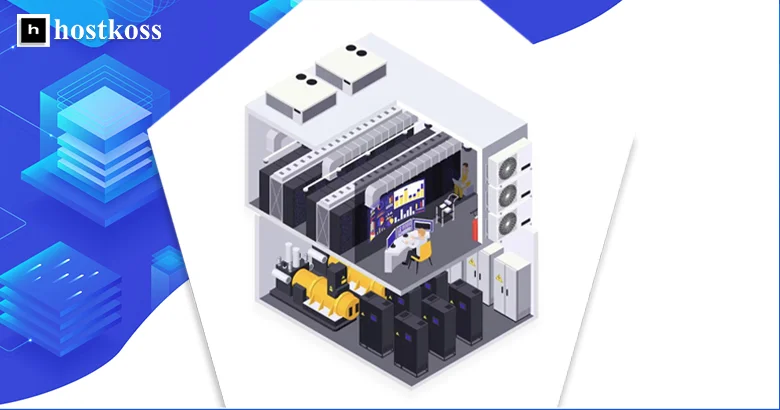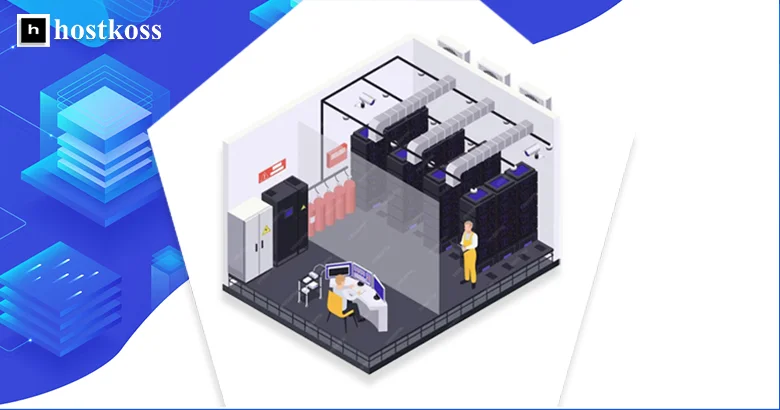A data center is a physical room or complex of rooms specially designed to store and process large amounts of information. From small server rooms to huge data centers, data centers play a critical role in ensuring the reliability, security and availability of data.
The main function of a data center is to ensure the smooth operation of information systems. This is achieved with the help of specialized equipment, which includes servers, switches, routers and other devices. Most modern data centers also have automation and monitoring systems that allow for efficient resource management and timely response to potential problems.
The growth in data volumes and processing requirements makes data centers extremely important for modern businesses. They are not only technical hubs, but also strategic assets that help organizations store, analyze, and use data to make informed decisions.
- How do data centers work?
- Types of data centers
- Components of a data center
- Evolution of data centers
- Data center infrastructure
- Data center management and maintenance
- Completing about data centers
- FAQs about data centers
How do data centers work?

The work of data centers is divided into several key stages. First, it is data storage. This is where servers are located that receive, process, and store huge amounts of information. This can be anything from emails to databases, from photos to videos.
Second, data centers are responsible for processing this data. They perform various operations, such as calculations, analysis, and transformation of information into a form that is understandable to the user. For example, when we search for something on the Internet, data centers perform complex search processes and display the results in a few seconds.
Finally, the third stage is data transmission. Data centers send information back to the user via the Internet. This happens instantly, thanks to the high bandwidth of network connections and optimized data transfer processes.
Thus, data centers play a key role in the functioning of the modern Internet, providing fast, reliable and secure data processing and transmission. They are invisible but critical parts of the digital world that allow us to enjoy all the benefits of the information age.
Types of data centers
In the world of data processing, there is a wide variety of approaches to creating data centers, tailored to different business objectives and needs. Each type has its own characteristics, advantages and disadvantages, so choosing the right option can be key to the success of a company’s operations.
The first type – corporate data centers, also known as on-premises data centers – involves the placement of the entire IT infrastructure right on the company’s premises. This option gives the company more control over data and security, which is especially important in the world of strict regulations such as GDPR or HIPAA. However, this approach requires considerable effort and cost to deploy and maintain the infrastructure.
The second type is public cloud data centers. They provide resources for shared use by customers via the Internet. This approach allows efficient use of resources, reducing infrastructure costs. Large providers such as AWS or Microsoft Azure operate hyperscale centers around the world, which ensures fast access and high availability.
The third type is managed and colocation centers, designed for organizations that do not have the ability or desire to run their own infrastructure. In a managed data center, the company rents servers and equipment, and the provider provides their administration. In a colocation center, the company owns its own infrastructure but rents space to house it.
When choosing a data center type, companies should consider their needs for security, availability, cost, and scalability. Sometimes a combination of different types can be the most optimal solution to meet all requirements.
Data center components
Data center components play an important role in ensuring the smooth and efficient operation of information systems. These elements form the basis for processing, storing and distributing large amounts of data in modern organizations.
Servers are the heart of any data center. They can be either hardware or software that provide the necessary functionality for information processing. Placed in special server racks, they provide data accessibility for computers via the network.
Network equipment is responsible for efficient data transmission and processing. It includes a variety of switching, routing, and load balancing tools that optimize network performance and ensure its security.
Data center storage is where all data and applications are stored and processed. It consists of a variety of technologies, software, and devices that provide reliable storage and access to information.
Software plays a key role in the functioning of data centers. It includes various programs and procedures that ensure the efficient operation of the entire information system.
The cabling infrastructure is an integral part of data centers, providing power and data transmission. Proper management of these systems is critical to preventing potential problems and maintaining business continuity.
Power infrastructure includes all the necessary elements that provide power to IT equipment. It includes redundant power to ensure that the system can continue to operate smoothly even in the event of an emergency.
The cooling infrastructure plays an important role in maintaining the optimal temperature in the room and preventing overheating of the equipment. It includes a variety of air conditioning and cooling systems that ensure the stable operation of the entire infrastructure.
Physical security is an integral part of any data center. It includes a variety of measures, such as alarms, electronic locks, and biometric scanners, to protect information and assets from unauthorized access.
Evolution of data centers
The evolution of data centers has been spectacular, undergoing significant transformations over the years to meet the ever-increasing demands of modern technology. From humble beginnings to sprawling, state-of-the-art facilities, the journey of data centers reflects the rapid pace of technological advancement and growing dependence on digital infrastructure.
In their early days, data centers were relatively simple, often consisting of a few servers housed in basic facilities. These rudimentary facilities were primarily focused on storing and processing data for relatively small operations. However, as technology evolved and the amount of data generated grew, the need for a more sophisticated infrastructure became apparent.
The next stage in the evolution of data centers was the move to larger, more centralized facilities capable of handling huge workloads. These data centers were equipped with advanced networking capabilities, robust security measures, and backup systems to ensure uninterrupted operations. Virtualization also played an important role during this period, allowing for efficient resource allocation and improved scalability.
As the digital landscape continued to evolve, so did data centers. The emergence of cloud computing introduced a new paradigm that allowed organizations to use off-site infrastructure for storage, processing, and other computing tasks. This marked a significant departure from traditional data center models, offering unprecedented flexibility, scalability, and cost-effectiveness.
In recent years, data centers have been implementing advanced technologies such as artificial intelligence, machine learning, and advanced computing. These innovations have further optimized performance, enhanced security, and enabled real-time data processing at the network edge. In addition, sustainability has become a key focus area, driving efforts to minimize energy consumption and reduce environmental impact through the introduction of renewable energy and efficient cooling solutions.
Looking ahead, the evolution of data centers shows no signs of slowing down. Emerging technologies such as quantum computing, 5G networks, and the Internet of Things (IoT) promise to revolutionize data center infrastructure once again, ushering in an era of unprecedented connectivity, intelligence, and efficiency. As the digital revolution continues to change our world, data centers will remain at the forefront, supporting the technologies that drive innovation and facilitate progress.
Data center infrastructure
When it comes to building a data center infrastructure, each stage is crucial. First of all, you need to carefully analyze your business needs and expected workloads. This helps to build a system that will be ready to meet the company’s needs, even in the long run.
Once the needs are identified, you should carefully choose a location for the data center. It is important to consider factors such as access to power, network connectivity, and the degree of protection from hazards. Choosing the right location can significantly increase the efficiency and reliability of the system.
The next step is to plan the physical infrastructure, including equipment placement, cooling and power supply. It’s important to consider scalability needs and power backup capabilities to ensure the data center is running smoothly.
System architecture is another important aspect. Careful consideration should be given to server placement, network equipment selection, and the creation of a monitoring and management system. This will help ensure efficient operation of the system and prevent possible problems in the future.
All of these steps require care and expertise to achieve a successful outcome. Data center infrastructure is not only a technical task, but also a strategic decision that affects the entire company’s operations.
Data center design and architecture
In the world of information technology, the task of designing and architecting data centers plays an important role in ensuring the efficiency and reliability of the infrastructure. Strategic planning for these centers requires an in-depth analysis of needs, technology requirements, and future trends.
One of the key trends in 2024 is the growing interest in mobile data centers created in the form of marine-type containers. This opens up new opportunities to increase mobility and speed of infrastructure deployment. However, the choice between traditional and mobile centers should be based on the specific needs of the project and its scale.
When designing a data center architecture, you should take into account not only current requirements, but also the projected increase in data volumes and technology development. Accordingly, you should carefully plan for power, cooling, security, and scalability of the infrastructure.
In addition, efficient energy use and reducing environmental impact are becoming increasingly important aspects of data center design. The use of energy-efficient technologies and the introduction of renewable energy sources helps to reduce costs and increase the sustainability of the infrastructure.
Power supply and cooling systems in the data center

When we talk about data centers, we often focus on the enormous scale, but few people think about how they function inside. Under the hood of these impressive structures are complex systems that provide power and cooling to keep the equipment running reliably.
As for the power supply, large UPS (uninterruptible power supplies) are used to provide a constant current in case of a grid failure. Diesel generators are also involved in this process, which start automatically in the event of a grid failure. This guarantees the constant availability of power supply, even in the most extreme situations.
As for cooling, the main system is water chillers. They are responsible for removing heat generated by servers and other equipment. The chillers use water to cool the air, which is then circulated through the server rooms. In addition, air conditioning systems and refrigeration units can also be used to maintain optimal temperatures.
Data centers are real engineering marvels that require a high level of expertise and technical equipment to ensure reliable operation of large amounts of data.
Network infrastructure in the data center
As we delve deeper into the world of data centers, the network infrastructure becomes an important foundation on which all other processes rest. Keeping this infrastructure running efficiently and reliably is a task that requires continuous improvement and attention to detail.
A variety of networking devices are used in data centers, including switches, routers, and firewalls. Switches are responsible for forwarding data within the center, providing fast and reliable communication between servers and other equipment. Routers are responsible for routing data between different networks, which can include internal data center networks, Internet connections, and external networks. Firewalls are used to ensure network security, access control, and traffic filtering.
In parallel, data centers also use network virtualization technologies. They allow you to optimize the use of network resources, providing flexibility and efficiency. Techniques such as dividing the network into virtual segments (VLANs) and using virtual network functions (VNFs) allow you to adapt the network infrastructure to specific needs and tasks.
One of the key requirements for a data center network infrastructure is its scalability. Systems must be ready to expand to accommodate the growth of data volumes and processing speed requirements. Therefore, the network architecture in a data center is often based on technologies that support horizontal scaling, such as a simplified server access network (Leaf-Spine or Clos topology).
All of this suggests that the network infrastructure in a data center is a complex and extensive system that requires constant improvement and management to ensure the efficient operation of the data center.
Data storage technologies in the data center
When considering data center storage technologies, it’s worth looking at the variety of methods used to ensure efficiency, reliability, and scalability.
One of the key components is storage systems based on hard disk drives (HDDs) and solid-state drives (SSDs). These systems provide fast access to data and reliable storage. HDDs are used for mass storage with high capacity, while SSDs provide high speed data access, especially in critical applications where speed is key.
Various backup technologies, such as RAID (Redundant Array of Independent Disks), are used to ensure fault tolerance and data recovery in the event of a disaster. RAID allows you to back up data on multiple disks, which provides protection against data loss in the event of a single disk failure.
A more modern approach is to use cloud-based storage systems. This allows for increased scalability and data availability, as well as reduced hardware and maintenance costs. Cloud-based solutions also provide automatic data backup and recovery, making them ideal for modern data centers.
In addition, data warehousing and data analytics technologies are used in data centers to optimize the work with large amounts of data. These technologies allow for efficient collection, storage and analysis of large amounts of data, which helps in comprehensive analysis and decision-making based on them.
Data center storage technologies are constantly evolving to ensure high efficiency, reliability and scalability in data processing and storage.
Security measures in the data center
Ensuring security in data centers is a critical task for any company or organization that works with large amounts of data. According to my IT expertise, addressing this challenge involves a number of strategies and measures to prevent possible threats and ensure data security.
One of the key elements is the use of advanced intrusion protection systems. This includes the use of firewalls, integrated intrusion detection and prevention systems (IDS/IPS), and access control systems. These measures allow detecting and blocking unwanted activity on the network, providing a high level of protection.
Additionally, an important part of data center security is protecting physical access to equipment. Controlled access to server rooms using biometric systems or access cards is an effective way to avoid unauthorized entry.
Cisco Systems, as a leading provider of technologies for data centers, uses a wide range of security equipment. This includes Cisco ASA (Adaptive Security Appliance) firewalls, Cisco Firepower integrated security solutions, and access control devices such as Cisco Identity Services Engine (ISE).
Effective security measures in the data center are an important component of an organization’s information security management. Their timely implementation helps to ensure data protection and avoid potential threats.
Data center management and maintenance
In my work, I use a wide range of tools and technologies to ensure the efficient operation of Data Centers. First, I use monitoring systems, such as Nagios or Zabbix, to constantly monitor the status of equipment, network, and software. This allows me to detect any anomalies and problems in time, ensuring reliable operation of the infrastructure.
In addition, I use configuration management tools such as Ansible or Puppet to automate routine tasks. They greatly facilitate the process of configuring equipment and implementing changes, helping to increase productivity and reduce the risk of errors.
In solving problems and conducting scheduled maintenance, I am guided by event-driven management methodologies such as ITIL or DevOps. This allows me to structure work processes, following best practices and ensuring their systematic and consistent nature.
To ensure data security and service reliability, I use a variety of backup technologies, from regular backups to the use of redundant Data Processing Centers (DR centers). This ensures data protection and availability in case of unforeseen situations or accidents.
Completing about data centers
I hope that after reading this article you have a better understanding of how important the role of data centers is in our digital world. However, this is only a part of all the knowledge related to IT infrastructure and technology.
I invite you to explore other materials on our portal, where we take a deeper look at technology development, data processing innovations, and other interesting aspects of the information world.
Don’t forget to share your impressions and opinions with us! Your feedback will help us create even more interesting and useful materials for you.
- What is disk space?
- What is the control panel
- What are log files
- How to check a website domain
- How to buy a domain for a website
Thank you for your interest in our publications, and we are waiting for you with new interesting topics on our portal!
FAQs about data centers
A data center is a specialized infrastructure designed to store, process, and manage large amounts of information.
The main function of the data center is to ensure the uninterrupted operation of information systems, data processing, as well as their security and availability.
The data center can process various types of data, including corporate information (financial data, customer data), data from Internet of Things (IoT) sensors, medical data, multimedia content, etc.
Data center components may include server hardware, storage systems, network equipment, data management and security software, automation and monitoring systems.
Companies gain more efficient data management, ensure data security and availability, use analytical tools to extract valuable insights from data, and scale their information needs.
Challenges can include high hardware and support costs, data security issues, energy efficiency and environmental concerns, and high availability.
Cloud technologies allow you to move part or all of your data processing infrastructure to the cloud, which can reduce the need for your own data centers, as well as provide greater flexibility and scalability.
Security measures can include physical access to the premises, data encryption, intrusion protection, data backup systems, and much more.
Globalization is increasing the need for distributed data centers that can provide information processing for companies and users in different parts of the world.
Data centers provide a platform for the development and implementation of new technologies, such as artificial intelligence, machine learning, and big data analytics, which foster innovation in many industries, from medicine to the automotive industry.



